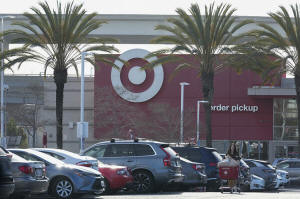Target posts strong Q4 profits and sales, but warns of cautious spending
as tariffs take hold
[March 05, 2025] By
ANNE D'INNOCENZIO
NEW YORK (AP) — Sales and profits slipped for Target during the crucial
holiday quarter as customers held back on spending, and the company said
there will be “meaningful pressure” on its profits to start the year
because of tariffs on Mexico, Canada and China and other costs.
Target CEO Brian Cornell told reporters Tuesday at its annual investor
meeting that shoppers will start seeing the prices of produce like
avocados, which come from Mexico, go up industrywide as early as in a
few days. He declined to comment specifically on what type of price
hikes shoppers will see on Target shelves. But Cornell warned that
shoppers will see price increases on certain goods at Target.
“I think things are unfolding so quickly,” Cornell said. “We will watch
this carefully and understand, are these long-term tariffs? Is this a
short-term action? How will this unfold over time? I think all of us are
speculating, and I think we’re going to listen and learn and make sure
that we can control the things we can control. But we don’t want to
overreact right now to one day and one headline.”
The retailer beat most quarterly estimates, however, but shares fell
nearly 3% in late afternoon trading as the overall market sell-off
continued. Target also said that sales declined in February in part
because of brutal weather that hurt apparel sales and declining consumer
confidence. It anticipates that sales could be unchanged for the year
amid increasing economic uncertainty.

Target's fiscal fourth-quarter results were announced the same day the
discounter held its annual investor meeting in New York. Target said it
plans to invest anywhere from $4 billion to $5 billion this year in new
store expansions, speeding up its online delivery, shortening its
production cycle and other initiatives. Shortening the time it takes to
get products to the shelves from conception will help the company stay
close to trends and also reduce risk of having too much inventory,
executives said.
Target plans to add 20 new stores this year, and it expects to add $15
billion in sales by 2030.
But tariffs and economic uncertainty loomed over the results.
President Donald Trump’s long-threatened tariffs against Canada and
Mexico went into effect Tuesday, pushing markets in Asia, Europe, and
the U.S. lower, and setting up costly retaliations by the United States’
North American allies, not to mention China.
China said Tuesday that it will impose additional tariffs of up to 15%
on imports of key U.S. farm products, including chicken, pork, soy and
beef, and also expanded controls on doing business with key U.S.
Americans have been pulling back on spending and retailers face a lot of
uncertainty in the year ahead.
[to top of second column] |

A Target parking lot in Emeryville, Calif., Friday, Feb. 28, 2025.
(AP Photo/Godofredo A. Vásquez)
 Target said that back in 2017, 60%
of its store-label products were sourced from China. That's now at
30%, Target executives said. The company is on its way to reducing
that number to 25% by the end of next year, the company said. That's
four years ahead of schedule. Target is shifting to sourcing in
Guatemala and Honduras and is looking to sourcing in the U.S.,
Target said.
Rick Gomez, Target’s chief commercial officer, said
Tuesday. Gomez said Target can't give specific price increases on
items right now because its teams are working out situations in real
time. For example, Target sells $3 Christmas ornaments, but it
doesn't want to go up to $3.60 so it may look to holiday stockings
to increase prices.
As for its $5 T-shirts, Gomez said it wants to keep that price so it
may look at dresses where there is more flexibility to raise prices.
“It's not as simple as just flowing through cost," Gomez said. "We
have to think about this from a consumer perspective and make sure
that our pricing architecture makes sense and puts us in a place
where we have affordable options."
Consumers have already been pulling back on discretionary spending
because the costs of groceries have risen so sharply. That is an
area where Target can be vulnerable because so much of its sales
come from discretionary items like clothing, electronics purchases.
Target reported net income of $1.1 billion, or $2.41 per share, far
better than the $2.26 that Wall Street was expecting, according to a
survey by FactSet. That is down from the $1.38 billion profit the
company reported in the same period last year, though the most
recent quarter had one fewer week of sales.
Revenue fell to $30.91 billion, from $31.9 billion, but that also
beat expectations.
Target said Tuesday its earnings per share for the current year will
be between $8.80 to $9.80. Wall Street had been projecting per-share
earnings of $9.29 for the year. The company expects net sales to be
up 1% and comparable sales to be flat this year.
During the most recent quarter, comparable sales — those from stores
and digital channels operating for at least 12 months — rose 1.5%.
That was higher than the 0.3% gain during the third quarter. Target
posted a 2% gain in the second quarter and a 3.7% drop in the first
quarter.
Speaking about the current quarter, Chief Financial Officer Jim Lee
said sales should pick up.
“We will continue to monitor these trends and will remain
appropriately cautious with our expectations for the year ahead,”
Lee said.
All contents © copyright 2025 Associated Press. All rights reserved |